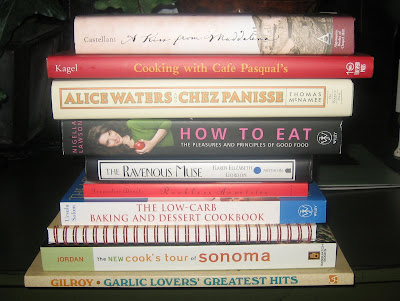Pork Chops with Apple Cider Sauce

Apologies for the poor picture quality. It's one thing to take a photo of food when it's just my DH and myself. He teases me about it, and loves to regale people with examples of when he's poised over his lovely plate of steaming food and I rush in with my camera and yell "wait!" It's another when we have a table full of guests and I'm poking around trying to take pictures in front of them. Tacky, tacky. So I snapped this picture on my own plate, as surreptitiously as possible, so it was a bit dark at our candlelit dining table.
My dinner menu the other night, when we entertained 4 friends for dinner:
- Hot & Spicy Tofu Herb Dip
- Manchego and Brie cheese on a slate with crackers
- Pork Chops with Apples and an Apple Cider Sauce
- Red Cabbage with Apples & Chestnuts
- Mashed Potatoes with Mascarpone
- Lemon Velvet Ice Cream with BLUE CHIP Chocolate Chip Cookies and Harlequin Pinwheel Cookies
Everything I've ordered from Niman ranch has been exceptionally good. Worth the price? Well, I guess it's relative. Compared to grocery chain meat, this is just far and away better. But if you're on a budget, probably not. I don't order all my meat from them - just special stuff. If you happen to decide to try them out - do wait for a sale - and make sure they pack in small packages (like 2 pork chops per pkg). That's why I hadn't defrosted these before, because I needed to wait for an occasion when I had exactly 6 people.
Because pork is raised so leanly now, there isn't as much fat to keep the meat moist. So I always brine pork. I've tried several recipes, but my current favorite is a mix that I buy at Whole Foods called V Traditional Brining Blend, and V Spicy Brining Blend. They come in 12.7 ounce jars. If you prepare the brine per the instructions you'll likely use most of a jar. I disregard those instructions and make a much smaller solution. This time I used about 2 tablespoons of brining salt and dissolved it in about a cup of boiling water, then added ice cubes to cool it off quickly. Usually I stick my finger in the brine to taste the saltiness - you want it to be salty, but not overwhelmingly salty, otherwise your meat will become the same. Then I immersed the pork in the brine. If time is of an essence, I'll put them in my aerator (a plastic container that removes the air by vacuum pump and supposedly increase the marinating ability chop-chop). That I did, and let them rest in the refrigerator for about 6 hours or so. I removed them once and turned them over in the liquid, since the brine didn't completely cover the chops.
I pan-seared the chops, then used a probe thermometer so I'd know exactly when the meat reached 145 degrees F. Worked like a charm. Result: these chops were just "the best." And America's Test Kitchen scored a winner with the sauce recipe. Although, next time I will probably thicken the sauce some with some cornstarch. Even though I reduced it down, it was still a bit thin. But, Niman Ranch scored a touchdown with the meat. One great dinner.
Pork Chops with Apple Cider Sauce Sauce
Recipe By: America's Test Kitchen
Servings: 4
32 ounces boneless pork top loin chops -- 4 chops, about 1 1/2 inches thick
Salt & pepper to taste
APPLE CIDER SAUCE:
1 1/2 cups apple cider -- or apple juice
1 cup low-sodium chicken broth
2 teaspoons cider vinegar
1 whole cinnamon stick
4 tablespoons unsalted butter -- cut into 4 pieces
2 large shallots -- minced, about 1/2 cup
1 whole tart apple -- Granny Smith, peeled, cored, sliced
1/4 cup Calvados -- or apple flavored brandy
1 teaspoon fresh thyme -- minced
Salt and pepper to taste
1. Brine the pork chops with a mixture of your choice.
2. Combine cider, chicken broth, and cinnamon stick in a medium saucepan. Simmer over medium-high heat until the liquid is reduced to one cup, about 10-15 minutes. Remove cinnamon stick and discard. Set aside.
3. Preheat oven to 425. Drain brine from pork chops, dry thoroughly, then season pork chops with pepper. Heat a heavy saute pan and add about 1 tablespoon of olive oil to pan. Quickly sear both sides of the pork until caramelized and golden brown. Remove chops to a heatproof pan, insert meat thermometer and bake until the pork reaches 145 degrees F. Remove from oven and loosely place a piece of foil over the top while finishing the sauce.
4. While pork is baking, in the same skillet you seared the pork, add a tablespoon of butter. Heat under medium-high heat, and when it's melted and foam subsides, add shallots and apple. Cook, stirring occasionally until softened and beginning to brown. Remove from heat and add the Calvados. Return to heat and cook about one minute, scraping bottom of pan with a wooden spoon to loosen browned bits. Add the reduced cider mixture and simmer until thickened slightly, and reduced to about 1 1/4 cups, about 3-5 minutes. Off heat whisk in remaining 3 tablespoons of butter, and adjust seasonings with salt and pepper.
5. Pour sauce with apples over each piece of pork and serve immediately.
NOTES : You might want to thicken the sauce more than the recipe indicates by using a tablespoon of cornstarch and a bit of water. Heat through until thickened.
Per Serving: 478 Calories; 22g Fat (44.3% calories from fat); 44g Protein; 19g Carbohydrate; 3g Dietary Fiber; 133mg Cholesterol; 100mg Sodium. Exchanges: 0 Grain(Starch); 6 Lean Meat; 0 Vegetable; 1 Fruit; 2 1/2 Fat; 0 Other Carbohydrates.
Printer-friendly recipe, click title at top.
























